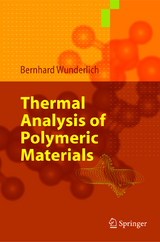Thermal Analysis of Polymeric Materials
Springer Berlin (Verlag)
978-3-540-23629-0 (ISBN)
Atoms, Small, and Large Molecules.- Basics of Thermal Analysis.- Dynamics of Chemical and Phase Changes.- Thermal Analysis Tools.- Structure and Properties of Materials.- Single Component Materials.- Multiple Component Materials.
From the reviews:
"It is not surprising that Wunderlich has written another excellent, comprehensive text. After all, he is one of the most well-respected leaders in the field of physical chemistry of polymers. By stressing the difference betwwen polymers and small molecules, this book provides the reader with an in-depth understanding of the thermal properties of all classes of molecules. Overall, this is one of the most comprehensive texts on thermal analysis of macromolecules. I highly recommend this book for both classroom study and for individuals hungry to expand their knowledge of thermal analysis and materials chemistry. Overall, I give this text an excellent rating." (Julie P. Harmon, J. Am. Chem. Soc., No. 42, 2005)
"This book is a perfect tool for polymer researchers ... and for researchers ... who want to incorporate polymer science into their studies. ... one of the most comprehensive texts on thermal analysis of macromolecules. ... represents years of effort ... for conveying his vast knowledge ... . contains excellent references ... . I highly recommend this book for both classroom study and for individuals hungry to expand their knowledge ... . I give this text an excellent rating." (Julie P. Harmon, Journal of the American Chemical Society, Vol. 127 (42), 2005)
"Macroscopic measurement by thermal analysis and the quantitative link to microscopic, molecular structure and mobility are systematically dealt with in this book. ... The aim of the book is to combine new material with a review of the classical aspects of the subject." (LabPlus international, Vol. 19 (3), June, 2005)
From the reviews:
"It is not surprising that Wunderlich has written another excellent, comprehensive text. After all, he is one of the most well-respected leaders in the field of physical chemistry of polymers. By stressing the difference betwwen polymers and small molecules, this book provides the reader with an in-depth understanding of the thermal properties of all classes of molecules. Overall, this is one of the most comprehensive texts on thermal analysis of macromolecules. I highly recommend this book for both classroom study and for individuals hungry to expand their knowledge of thermal analysis and materials chemistry. Overall, I give this text an excellent rating." (Julie P. Harmon, J. Am. Chem. Soc., No. 42, 2005)
"This book is a perfect tool for polymer researchers … and for researchers ... who want to incorporate polymer science into their studies. … one of the most comprehensive texts on thermal analysis of macromolecules. … represents years of effort … for conveying his vast knowledge … . contains excellent references … . I highly recommend this book for both classroom study and for individuals hungry to expand their knowledge … . I give this text an excellent rating." (Julie P. Harmon, Journal of the American Chemical Society, Vol. 127 (42), 2005)
"Macroscopic measurement by thermal analysis and the quantitative link to microscopic, molecular structure and mobility are systematically dealt with in this book. … The aim of the book is to combine new material with a review of the classical aspects of the subject." (LabPlus international, Vol. 19 (3), June, 2005)
| Erscheint lt. Verlag | 4.4.2005 |
|---|---|
| Zusatzinfo | XVI, 894 p. 947 illus. |
| Verlagsort | Berlin |
| Sprache | englisch |
| Maße | 155 x 235 mm |
| Gewicht | 1405 g |
| Themenwelt | Naturwissenschaften ► Chemie ► Organische Chemie |
| Technik ► Maschinenbau | |
| Schlagworte | Material Science • Polymere • Polymers • Solid state physics • structure-property relationship • Thermal Analysis • Thermoanalyse • thermodynamics |
| ISBN-10 | 3-540-23629-5 / 3540236295 |
| ISBN-13 | 978-3-540-23629-0 / 9783540236290 |
| Zustand | Neuware |
| Haben Sie eine Frage zum Produkt? |
aus dem Bereich




